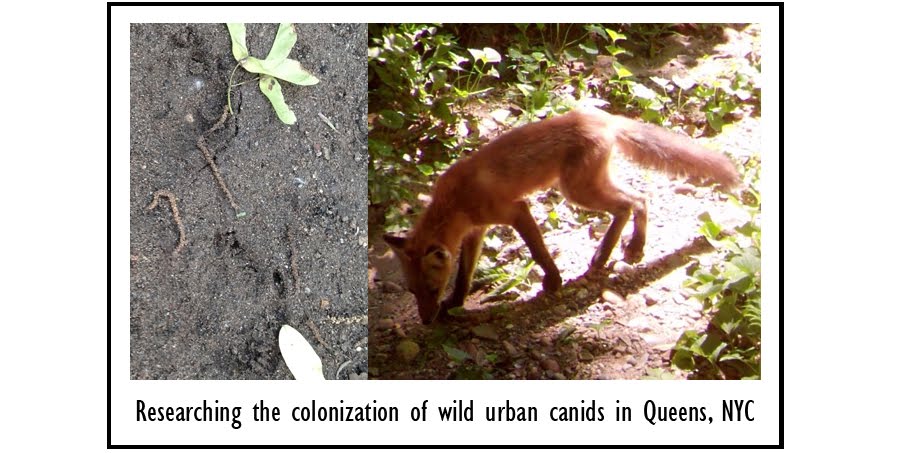- http://www.nydailynews.com/new-york/queens/animal-control-officers-set-trap-rochdale-village-coyote-spotted-article-1.418192
- http://www.timesledger.com/stories/2010/11/laurelton_times_newskbxwqzi03102010.html
- http://nymag.com/news/features/coyotes-2014-2/
- http://nypost.com/2011/01/23/coyotes-grave-love-prospects/
- http://nypost.com/2004/01/27/queens-coyote-goes-with-floe/
Wednesday, July 30, 2014
Sightings Map of Coyotes in Queens
Below is a map of Coyote sightings that have been reported in the media in Queens. Mouse over the markers for the specific locations and year of sighting.
Friday, July 25, 2014
About Queens Canid Research
My name is Brad Gibson and I am
researching wild urban canids in the borough of Queens, NYC. It has been thought
coyotes are traveling into Queens from upstate NY via railroad lines. My
intention is to document this dispersal and colonization. The methods
used are non-lethal and non-conspicuous. I have examined locations
around Queens that could potentially harbor Fox and Coyote. In these locales I
have looked for signs of their presence on foot, and have set up motion
activated cameras for long term observation. In the coming days, weeks,
and months I will share with you what I have found.
Sunday, July 20, 2014
An Introduction to NYC Coyotes
Welcome. After having observed the Locust Manor Long Island
Railroad Coyote in Queens, NYC in the fall of 2012 I became fascinated
with the possibility of Coyotes living in the United States most
populous Metropolis. Coyotes have been in the Bronx for some time now,
and are widely accepted as being residents of that borough. The Bronx is
connected to Westchester County and thus Upstate NY, hence Coyotes colonization there is to be expected. Coyotes in Manhattan are a surprise however,
as there is little habitat for them, along with the fact that Manhattan
is an Island and is thus isolated from the mainland. Every year Coyotes
are spotted in Manhattan and these rogues are presumed to have crossed
railroad tracks, bridges, or even swam across the East and/or Hudson
rivers. Unlike the Bronx, the Coyotes in Manhattan are not residents,
they are roaming vagrants that always end up captured and relocated.
Brooklyn has had very few Coyote sightings. This is likely due to the
lack of parks in the Borough, and the lack of potential travel paths a
Coyote could use to get there. Queens is home to the city's only
non-Bronx resident Coyote(s). The Locust Manor Long Island Railroad
station is adjacent to a small parcel of wooded land. Coyotes were first
spotted there in 2010 and as recently as last year. I witnessed a
large, darker-than-usual color morph, Coyote there in 2012.
The Coyotes in NYC, like all Coyotes in the Northeastern United States, are not genetically pure. Canis Latrans historically is a Western species. Gray Wolves, as a competitor and adversary, kept Coyote population numbers in check and in a specific geographic area. However as the United States was industrialized, forests were destroyed and along with them the creatures that inhabited them. Wolves were exterminated from nearly the entire Eastern half of the country. This left no wild canids and a large niche to fill. By the early 20th century deforestation had slowed, and by the mid 20th century forested land was rebounding. Coyotes, being more adaptable than Wolves, started moving East. The Coyotes moving towards the Southeast remained more or less pure Coyotes, however the ones coming Northeast met up with Canis Lycaon, the Eastern Wolf, in Canada. The Wolf numbers were low, so they readily interbred with these migrating Coyotes creating a Coywolf that populated the Northeast. Every Coyote in the Northeast is in reality a Coywolf, some containing as much as 80% wolf DNA. For the sake of simplicity this blog will refer to these Coywolfs that inhabit NYC simply as Coyotes.
Source:
Genetic Characterization of Eastern “Coyotes” in Eastern Massachusetts. By Way, Rutledge, Wheeldon, White. Northeastern Naturalist 17(2):189-204.
The Coyotes in NYC, like all Coyotes in the Northeastern United States, are not genetically pure. Canis Latrans historically is a Western species. Gray Wolves, as a competitor and adversary, kept Coyote population numbers in check and in a specific geographic area. However as the United States was industrialized, forests were destroyed and along with them the creatures that inhabited them. Wolves were exterminated from nearly the entire Eastern half of the country. This left no wild canids and a large niche to fill. By the early 20th century deforestation had slowed, and by the mid 20th century forested land was rebounding. Coyotes, being more adaptable than Wolves, started moving East. The Coyotes moving towards the Southeast remained more or less pure Coyotes, however the ones coming Northeast met up with Canis Lycaon, the Eastern Wolf, in Canada. The Wolf numbers were low, so they readily interbred with these migrating Coyotes creating a Coywolf that populated the Northeast. Every Coyote in the Northeast is in reality a Coywolf, some containing as much as 80% wolf DNA. For the sake of simplicity this blog will refer to these Coywolfs that inhabit NYC simply as Coyotes.
Source:
Genetic Characterization of Eastern “Coyotes” in Eastern Massachusetts. By Way, Rutledge, Wheeldon, White. Northeastern Naturalist 17(2):189-204.
Subscribe to:
Posts (Atom)
